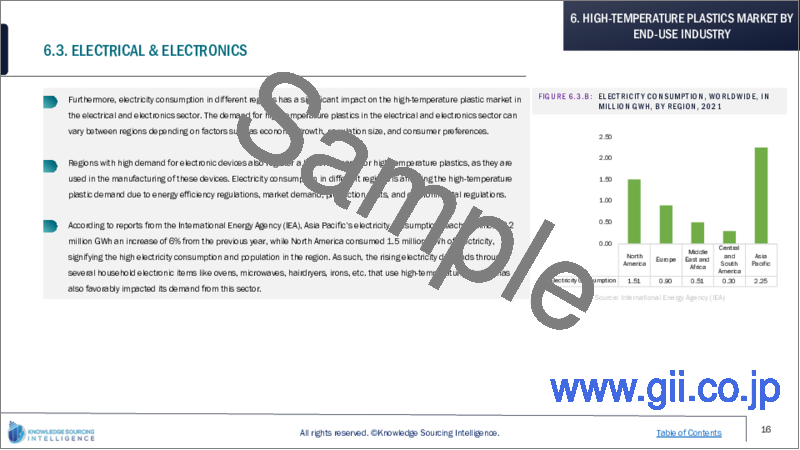|
|
市場調査レポート
商品コード
1122529
高耐熱性プラスチック(HTP)の世界市場予測(2022年~2027年)High-Temperature Plastics Market - Forecasts from 2022 to 2027 |
||||||
|
● お客様のご希望に応じて、既存データの加工や未掲載情報(例:国別セグメント)の追加などの対応が可能です。 詳細はお問い合わせください。 |
|||||||
| 高耐熱性プラスチック(HTP)の世界市場予測(2022年~2027年) |
|
出版日: 2022年08月01日
発行: Knowledge Sourcing Intelligence
ページ情報: 英文 120 Pages
納期: 即日から翌営業日
|
- 全表示
- 概要
- 目次
世界の高耐熱性プラスチック(HTP)の市場規模は、2020年の329億9,100万米ドルから、予測期間中に4.85%のCAGRで成長し、2027年には459億6,200万米ドルになると予測されます。
高耐熱性プラスチック(HTP)は、幅広い温度範囲にさらされる人々にとって、寸法安定性が高く、優れた機械的品質を備えているため、高い需要があります。
一方、高耐熱性プラスチック(HTP)の価格上昇は、予測期間を通じて市場の拡大を抑制すると予想されます。また、新興国での需要増加により、今後数年間はこの分野のさらなる成長が見込まれています。しかし、高耐熱性プラスチック(HTP)の製造が困難であることが、近い将来、市場の成長に対する厳しい障害となる可能性があります。
当レポートでは、世界の高耐熱性プラスチック(HTP)市場を調査しており、市場の促進要因や抑制要因、セグメントや地域別の分析、競合情勢、企業プロファイルなどを提供しています。
目次
第1章 イントロダクション
- 市場概要
- COVID-19シナリオ
- 市場の定義
- 市場セグメンテーション
第2章 調査手法
- 調査データ
- 前提
第3章 エグゼクティブサマリー
- 調査のハイライト
第4章 市場力学
- 市場促進要因
- 市場抑制要因
- ポーターのファイブフォース分析
- 売り手の交渉力
- 買い手の交渉力
- 新規参入業者の脅威
- 代替品の脅威
- 機能における競合関係
- 機能のバリューチェーン分析
第5章 高耐熱性プラスチック(HTP)市場:タイプ別
- フッ素樹脂
- ポリフェニレンサルファイド
- ポリイミド
- ポリスルホン
- その他
第6章 高耐熱性プラスチック(HTP)市場:エンドユース業界別
- 輸送
- 電気・電子
- 工業
- 医療
- その他
第7章 高耐熱性プラスチック(HTP)市場:地域別
- イントロダクション
- 北米
- 米国
- カナダ
- メキシコ
- 南米
- アルゼンチン
- ブラジル
- その他
- 欧州
- 英国
- ドイツ
- フランス
- イタリア
- その他
- 中東・アフリカ
- アラブ首長国連邦
- イスラエル
- サウジアラビア
- その他
- アジア太平洋地域
- 中国
- インド
- 日本
- 韓国
- オーストラリア
- インドネシア
- タイ
- その他
第8章 競合環境と分析
- 主要企業と戦略分析
- 新興企業と市場の収益性
- 合併、買収、契約、コラボレーション
- ベンダーの競争力マトリックス
第9章 企業プロファイル
- Solvay
- DuPont
- SABIC Innovative Plastics
- Celanese Corporation
- Victrex plc
The high-temperature plastics market is projected to witness a CAGR of 4.85% during the forecast period to grow from US$32.991 billion in 2020 to US$45.962 billion in 2027. Plastics that are employed in high-temperature applications are known as high-temperature plastics. Due to their inadequate use and high cost, HTPs are classed as speciality polymers. These plastics are produced in small quantities (less than 1% of the total plastics market) for their applications. Durability and high mechanical qualities are also provided by HTPs at high temperatures. HTPs should be used at temperatures of 1500 degrees Celsius or higher. These materials are in high demand because they are more dimensionally stable and have superior mechanical qualities for people who have been exposed to a wide range of temperatures. Abrasion and hardness, wear and UV resistance, chemical resistance, and fire resistance are all important characteristics of high-temperature plastics.
On the other hand, the increasing price of high-temperature plastics is expected to stifle the market's expansion throughout the projected period. Furthermore, increased demand in developing countries will create further prospects for this sector to grow in the years ahead. However, the difficulty in manufacturing high-temperature plastics may present a severe hurdle to the market's growth in the near future.
High-Temperature Plastics Market Trends:
The growth in the replacement of traditional materials and the growth of the market in the aerospace and automotive industries are projected to drive the growth of the high-temperature plastics industry in the predicted future. Furthermore, the improved economic conditions are anticipated to support the high-temperature plastics market forward. Furthermore, the market for high-temperature plastics is expected to benefit from the particular properties of these materials.
High-Temperature Plastics Market Growth
- Demand in Different Industries
The increased demand for plastics in the automotive, electronics, and construction industries is helping the market to grow over a forecast period. Polyimides are high-performance polymers with excellent thermal and electrical resistance and high strength. They're common in the automotive and transportation industries, as well as consumer goods and electrical and electronic applications. Polypropylene's high-temperature capability will fuel the growth of the market plastic. Fluoropolymers will become more popular as the packaging industry grows in demand. Fluoropolymers are omnipresent in modern life, appearing everywhere from packaged foods to non-stick cooking pan coatings. Fluoropolymers have been shown to be versatile materials that can meet a variety of industrial demands.
- Increase in the automobile industry is increasing.
The growth of the automobile industry for high-temperature polymers during a forecast period. The substance is used as an insulator for passenger seats, circuit boards, automobile roofs, and external laminating panels inside the automotive and manufacturing industries. The marketplace for vehicle applications is expanding, and with greater performance and stricter environmental restrictions, the market is projected to expand much more in the future.
- Replacement For Metals
The rising utilization of plastic as a replacement for metals in various machine parts, such as gears and pulleys, is likely to help the market develop significantly over the forecast period of the report. However, as manufacturers increasingly use high-temperature polymers to construct engine parts, market consumption is expected to grow rapidly.
High-Temperature Plastics Market Restraints
- High Temperature
While using high-temperature plastics in clinical applications, it is important to note that polymers are brittle and difficult to work with. Medical equipment is frequently heated, but it also faces a variety of environmental threats such as abrasions, cuts, and pressures. Furthermore, high-temperature plastic is more expensive, making it unsuitable for many healthcare uses. This is among the most significant obstacles to overcome when employing high-temperature plastics in therapeutic diagnostics. Considerable-temperature plastics are also difficult to form into complicated shapes and are typically brittle and stiff, making them unsuitable for applications requiring high flexibility and strength.
High-Temperature Plastics Market Segmentation:
- By Type
Based on the type, the market is divided into Polyphenylene Sulphide, Fluoropolymers, Polyimides, Polysulfones, and Others. Fluoropolymers are the most common sort of high-end plastic, with the fastest growth rate throughout the forecast period. Despite the fact that progress in this huge sector is likely to lag behind the standard, products that can be produced will strive to bring the strongest growth chances due to their market size. Overall benefits will be aided by the extensive usage of polytetrafluoroethylene in the large industrial market, especially as possibilities in applications such as chemical synthesis and commercial filtration continue to emerge.
- By End-User
Based on the end-user, the market is divided into transportation, industrial, electrical & electronics, and medical, and others. The global downturn and the installation of higher emission rules are currently posing challenges to the automotive industry. However, both advanced and emerging markets are likely to see significant growth by the end of the global automotive market.
- By Geography
During the projected period, Asia-Pacific will be the most prominent market for high-temperature plastics. The strong expansion in the automotive and aerospace industries, combined with a transfer of production hubs from western areas to Asia-Pacific, is propelling the HTP market in Asia-Pacific. The rising demand for passenger automobiles in emerging economies like India, China, Japan, and South Korea is stifling the market for high-temperature plastics.
Impact of COVID-19
The global demand for high-temperature polymers has been impacted by the reduced demand from end-use sectors during the COVID-19 lockout. Demand for high-temperature plastic has been 40-50 percent lower than typical around the world. Hard PVC, polypropylene plastic materials, polycarbonate, and have been the most damaged. This has resulted in the closure of big plants that create barrels and other equipment, causing numerous plastics companies to temporarily lose capacity. Additionally, the global economic shutdown has contributed in a prolonged business disruption for numerous plastic product providers, resulting in the temporary closure of many significant plastic enterprises.
Competitive Insights
A competitor's details are provided in the high-temperature plastics market competitive marketplace. Company overview, financials, income generated, economic feasibility, investment in R&D, emerging market approaches, a worldwide brand, production sites as well as facilities, capacity utilization, company advantages and disadvantages, successful launch, product circumference and comprehensiveness, and application dominance are among the details included. Some major market players are Solvay, DuPont, SABIC Innovative Plastics, Celanese Corporation, and Victrex. For instance, SABIC will advance thermoplastic solutions for essential EV battery technologies in April 2021.
Segmentation
- By Type
Fluoropolymers
Polyphenylene Sulphide
Polyimides
Polysulfones
Others
- By End-Use Industry
Transportation
Electrical & Electronics
Industrial
Medical
Others
- By Geography
North America
- U.S
- Canada
- Mexico
South America
- Argentina
- Brazil
- Others
Europe
- UK
- Germany
- France
- Italy
- Others
Middle East and Africa
- UAE
- Israel
- Saudi Arabia
- Others
Asia Pacific
- China
- India
- Japan
- South Korea
- Australia
- Indonesia
- Thailand
- Others
TABLE OF CONTENTS
1. Introduction
- 1.1. Market Overview
- 1.2. Covid-19 Scenario
- 1.3. Market Definition
- 1.4. Market Segmentation
2. Research Methodology
- 2.1. Research Data
- 2.2. Assumptions
3. Executive Summary
- 3.1. Research Highlights
4. Market Dynamics
- 4.1. Market Drivers
- 4.2. Market Restraints
- 4.3. Porter's Five Forces Analysis
- 4.3.1. Bargaining Power of Suppliers
- 4.3.2. Bargaining Power of Buyers
- 4.3.3. Threat of New Entrants
- 4.3.4. Threat of Substitutes
- 4.3.5. Competitive Rivalry in the Function
- 4.4. Function Value Chain Analysis
5. High-Temperature Plastic Market By Type
- 5.1. Fluoropolymers
- 5.2. Polyphenylene Sulphide
- 5.3. Polyimides
- 5.4. Polysulfones
- 5.5. Others
6. High-Temperature Plastic Market By End-Use Industry
- 6.1. Transportation
- 6.2. Electrical & Electronics
- 6.3. Industrial
- 6.4. Medical
- 6.5. Others
7. High-Temperature Plastic Market By Geography
- 7.1. Introduction
- 7.2. North America
- 7.2.1. U.S
- 7.2.2. Canada
- 7.2.3. Mexico
- 7.3. South America
- 7.3.1. Argentina
- 7.3.2. Brazil
- 7.3.3. Others
- 7.4. Europe
- 7.4.1. UK
- 7.4.2. Germany
- 7.4.3. France
- 7.4.4. Italy
- 7.4.5. Others
- 7.5. Middle East and Africa
- 7.5.1. UAE
- 7.5.2. Israel
- 7.5.3. Saudi Arabia
- 7.5.4. Others
- 7.6. Asia Pacific
- 7.6.1. China
- 7.6.2. India
- 7.6.3. Japan
- 7.6.4. South Korea
- 7.6.5. Australia
- 7.6.6. Indonesia
- 7.6.7. Thailand
- 7.6.8. Others
8. Competitive Environment and Analysis
- 8.1. Major Players and Strategy Analysis
- 8.2. Emerging Players and Market Lucrativeness
- 8.3. Mergers, Acquisitions, Agreements, and Collaborations
- 8.4. Vendor Competitiveness Matrix
9. Company Profiles
- 9.1. Solvay
- 9.2. DuPont
- 9.3. SABIC Innovative Plastics
- 9.4. Celanese Corporation
- 9.5. Victrex plc




